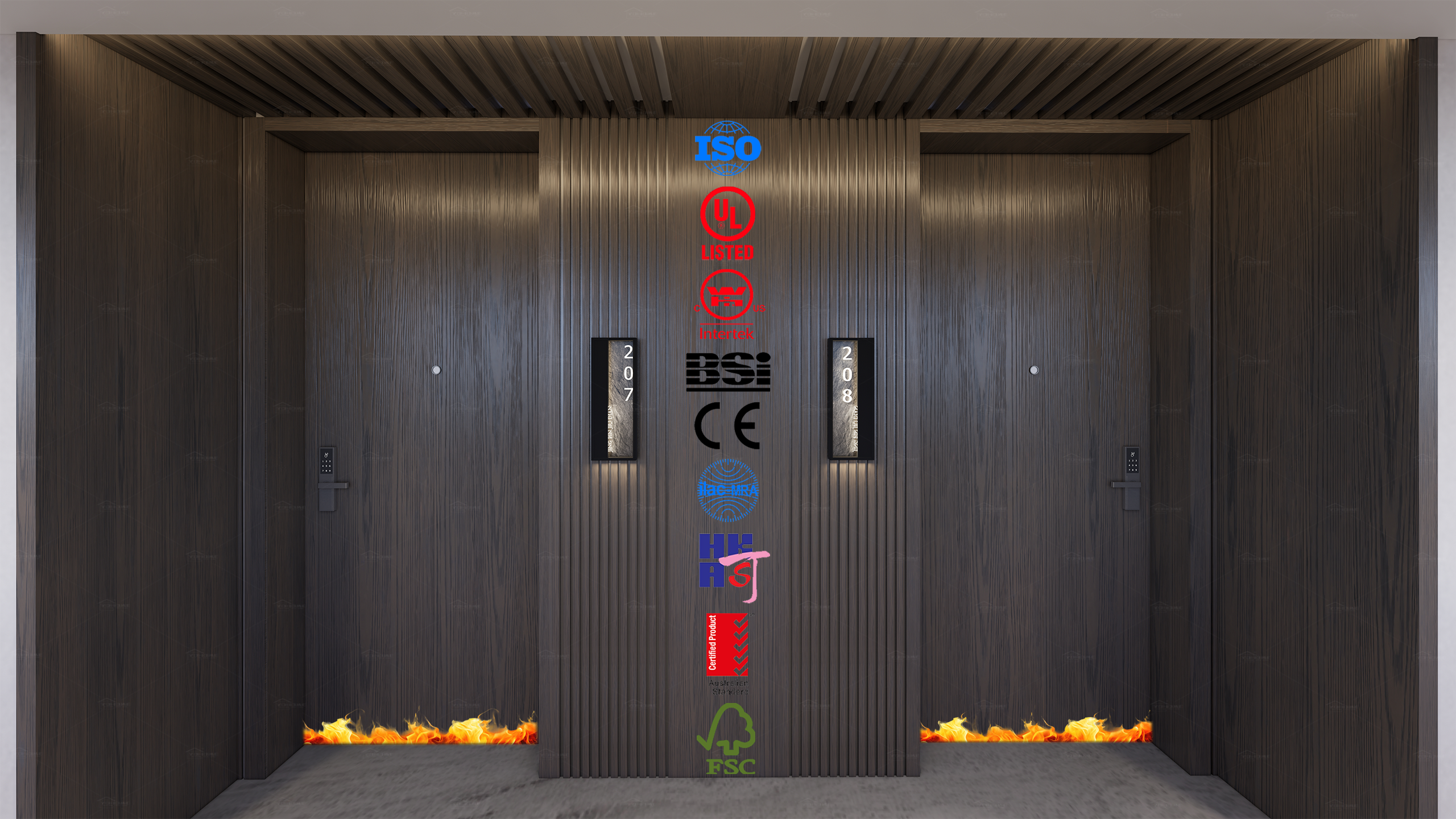What are the interior doors?
What are the interior doors?

What are Interior Doors?
Interior doors are essential elements in every home or building. They separate rooms, provide privacy, and contribute to the overall design of your living space. Unlike exterior doors, which protect the home from outside elements, interior doors focus on functionality and aesthetic appeal within the building. They are an integral part of creating the right atmosphere in a room, whether for privacy, light control, or simply for enhancing the look of a space.
Function of Interior Doors
The main function of interior doors is to divide and organize spaces. They create clear boundaries between rooms, which helps maintain privacy and keep different areas of the home distinct. Whether separating a bedroom from the rest of the house or closing off a bathroom, interior doors are key in keeping rooms functional and defined.
In addition to privacy, interior doors also help with sound control. For example, a solid wood door can help reduce noise from outside or other parts of the house. This is particularly important in a home with multiple people or noisy areas like a living room or kitchen. If you work from home or need peace, an interior door can help create a more peaceful environment.
Interior doors also serve as barriers to keep warmth or cool air within a room. For instance, during the colder months, closing an interior door can help maintain the temperature in a bedroom, preventing cold air from seeping in. Similarly, during the summer, closing doors can keep cool air from escaping, improving energy efficiency in your home.
Importance of Interior Doors
Interior doors are more than just functional; they play a crucial role in a home’s overall atmosphere and aesthetic. The right interior door can enhance the look of a room, provide a sense of privacy, and even increase the value of your home.
First, internal doors contribute significantly to the room’s overall style. Whether you choose sleek, modern flush doors or classic, detailed panel doors, the design of your doors sets the tone for the entire room. Doors are often overlooked in design, but they can make a big difference in the look and feel of your space. A well-chosen interior door can blend seamlessly with the rest of your decor, adding style and elegance.
Moreover, internal doors offer a sense of security and personal space. In homes with multiple people or apartments, doors help create private retreats. Whether it’s a bedroom, bathroom, or home office, having a door provides a sense of personal space, essential for comfort and well-being.
Finally, inside doors also improve the overall functionality of a home. They help with organization, define spaces, and even affect how traffic flows in a home. For example, a bifold door is perfect for a small closet or pantry, while French doors work well in a larger space like a living room, offering separation and an open feeling. By improving both the flow of a home and the privacy of its rooms, interior doors are essential in creating a space that works for you.
Types of Interior Doors
Various interior doors are designed to serve different functions and suit multiple styles. Whether you’re looking for a door that offers privacy, enhances a room’s design, or provides space-saving solutions, there’s an interior door for every need. Here’s a breakdown of some of the most popular types:
Slat Doors
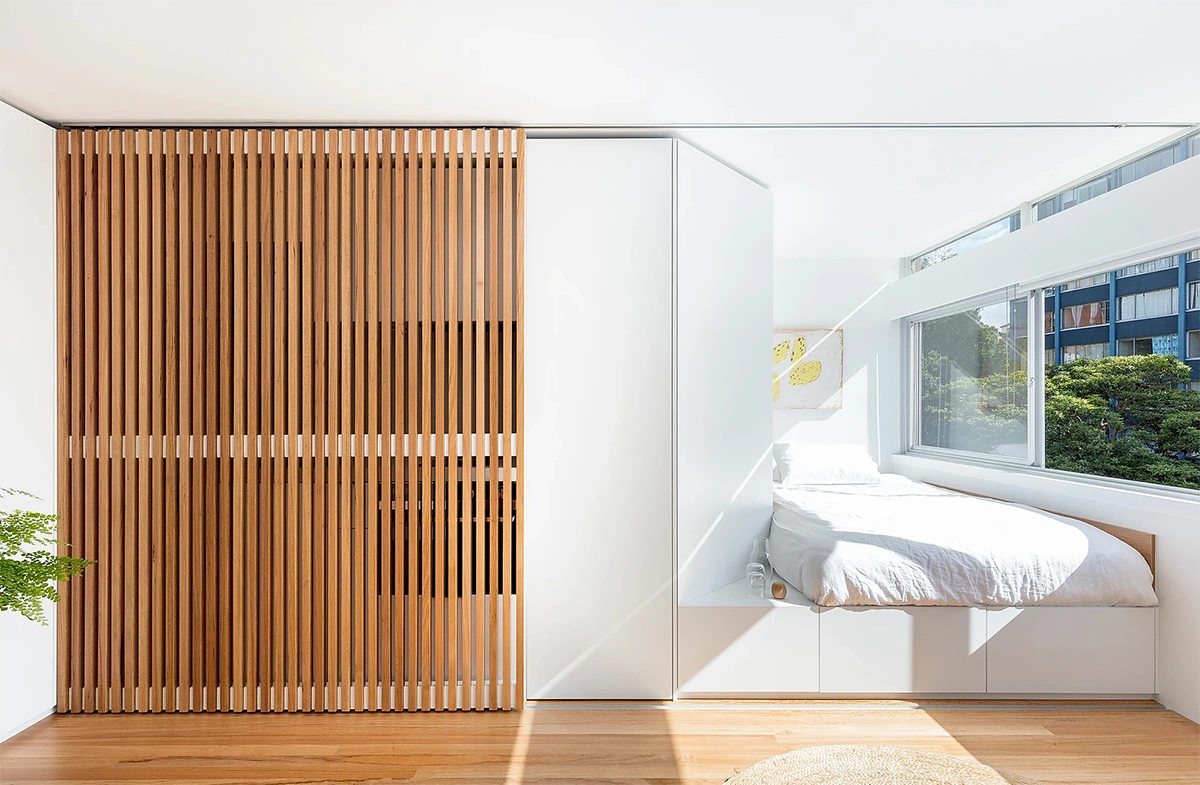
Slat doors are one of the most traditional and versatile interior doors. They typically feature a series of rectangular or square panels, which can be solid or glazed. These panels are arranged in various patterns, creating a classic or contemporary look depending on the design.
Slat doors are often made from wood, which gives them a sturdy, traditional feel. They are ideal for adding warmth and texture to a room. Because of their aesthetic flexibility, slat doors can fit into many styles, from colonial to modern homes. Whether you want something simple with fewer panels or more intricate designs with detailed moldings, panel doors offer numerous options.
In addition to style, slat doors are functional. They are great for privacy and sound insulation. Their solid construction helps minimize noise between rooms, making them a good choice for bedrooms or home offices.
Flush Doors
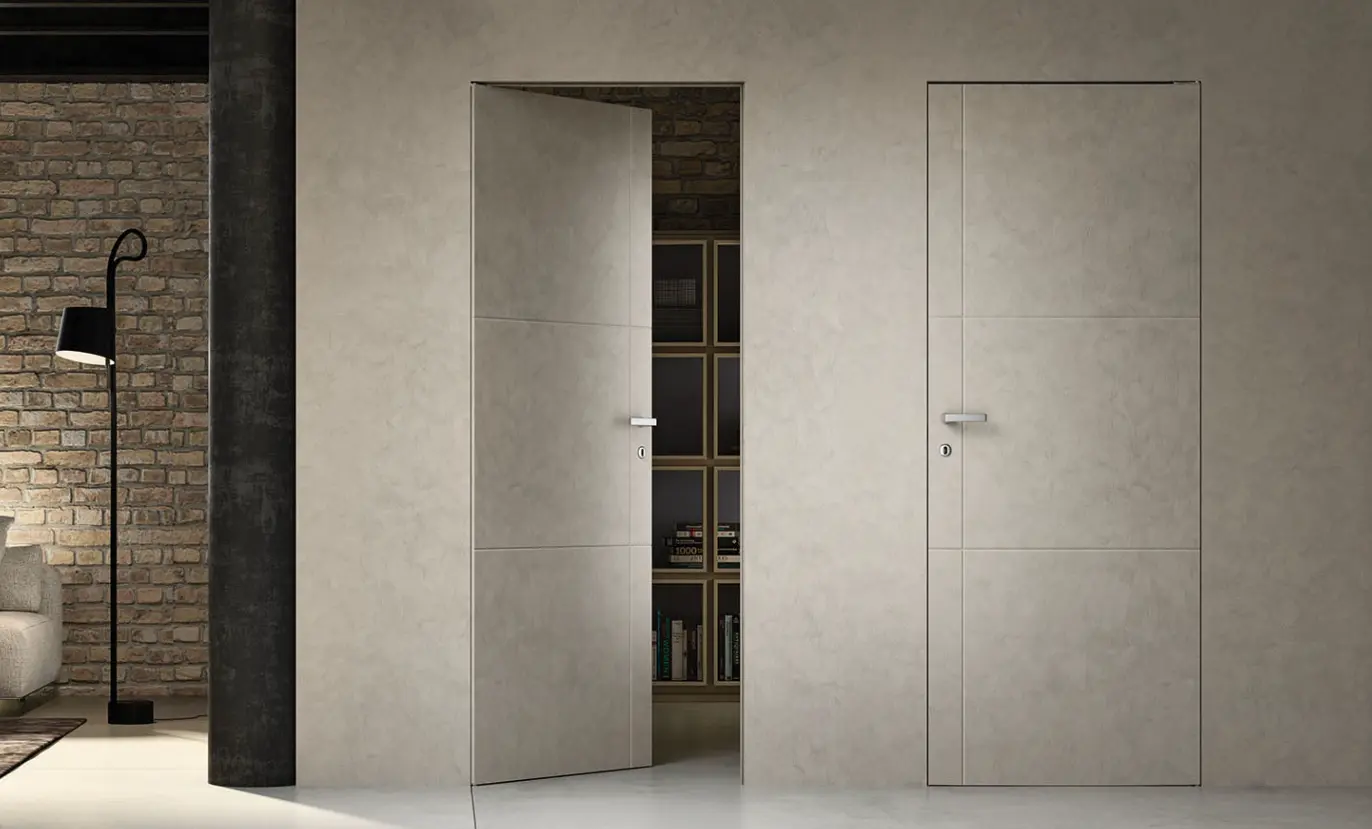
Flush doors are known for their smooth, flat surfaces, making them the simplest and most minimalist option for interior doors. Unlike panel doors, flush doors have no visible panels or designs—just a smooth, flat surface, which gives them a sleek, clean look. They are perfect for modern, contemporary spaces where simplicity is key.
Typically made of wood or engineered wood, flush doors are lightweight and easy to maintain. They can be painted or veneered to match any interior decor. Flush doors are an excellent choice for those who prefer a minimalist design or wish to make a space look more spacious and airy.
Despite their simplicity, flush doors provide good privacy and noise control. Their smooth surface makes them easy to clean, a plus in high-traffic areas like hallways or bathrooms.
French Doors
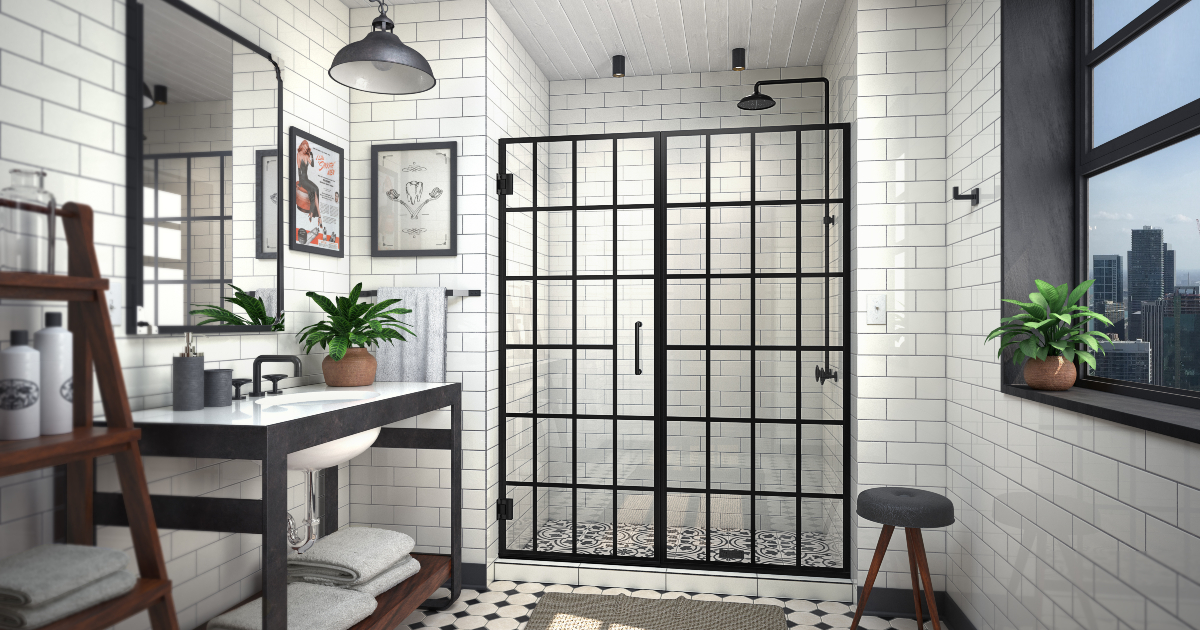
French doors are an elegant and timeless choice for any home. These doors consist of two panels, usually made of glass, that open outward to provide a wide, open passage. The glass panels allow natural light to flow between rooms, which can help make spaces feel larger and more connected.
French doors are often used to connect a living room to a dining room or a home office to the rest of the house. They add charm and sophistication, making them perfect for areas where you want to create an open, airy feel while maintaining some level of separation.
One of the key benefits of French doors is their ability to blend beauty with functionality. While they provide a degree of privacy, the large glass panels ensure that light flows freely between spaces. They are also perfect for opening up a room to a patio, garden, or balcony, adding a touch of luxury to any home.
Barn Doors

Barn doors have become increasingly popular in modern interior design thanks to their rustic charm and unique functionality. These doors slide along a track, making them a great choice for spaces where a swinging door might take up too much room. Typically made from wood, barn doors add a rustic, farmhouse feel to the space.
Barn doors are often used in kitchens, bathrooms, or as closet doors. Their sliding mechanism is not only space-saving but also visually striking. They offer a stylish solution for dividing rooms without hinges or traditional door frames.
In addition to their practicality, barn doors are available in various styles, ranging from simple, minimalist designs to more detailed, barn-inspired looks with hardware that highlights their rustic charm. Barn doors could be the perfect fit if you want to add a unique and trendy feature to your home.
Bifold Doors
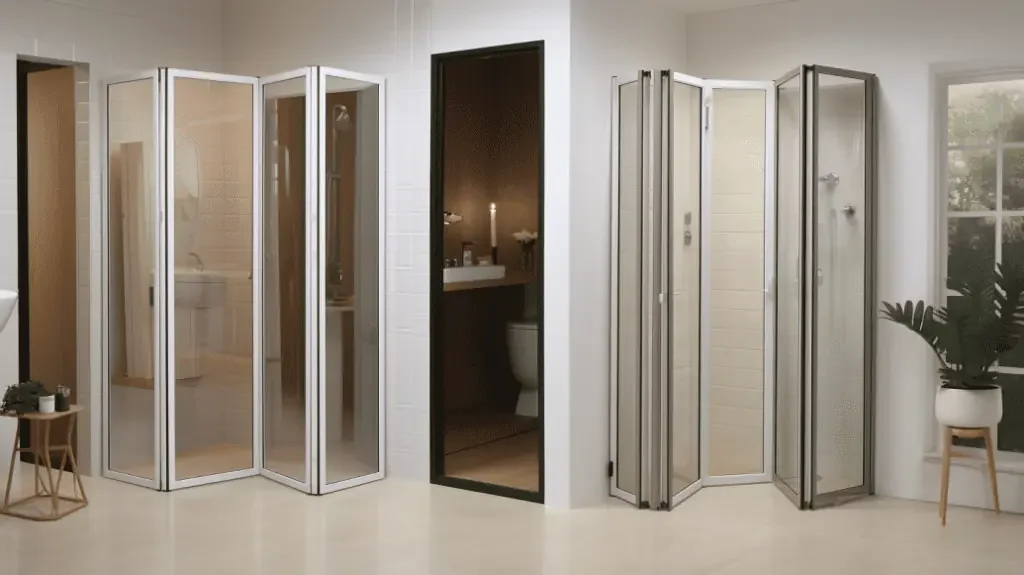
Bifold doors are an excellent solution for spaces where you want to save space while still having a functional, stylish door. These doors comprise two or more panels that fold together, creating a compact, space-saving design. Bifold doors are commonly used in closets, pantries, or laundry rooms.
Bifold doors are often made from lightweight materials like MDF, composite wood, or sometimes even glass. They’re ideal for smaller spaces where a traditional swinging door would take up too much room. In a closet, for example, bifold doors allow for easy access to the contents without needing extra floor space for the door to swing open.
These doors are not just practical; they come in various finishes to match your home’s decor. Bifold doors can complement many design styles, from smooth painted surfaces to natural wood finishes. They are also relatively easy to install, making them popular for DIY projects.
Paint Doors

A paint door is a versatile and popular choice for many homes. These doors are typically made from wood or MDF (Medium Density Fiberboard) and are designed to be painted in any color that matches your interior decor. One of the main advantages of paint doors is their flexibility. You can customize them to fit any design theme, from bold, bright colors to soft pastels or neutral tones.
The smooth surface of paint doors makes them easy to clean and maintain. They are commonly used in living rooms, bedrooms, and hallways. Since they can be painted to match any room’s color scheme, paint doors offer a seamless way to blend with the rest of the room. They’re especially great for modern or minimalist interiors with a clean, simple look.
Invisible Doors

An invisible door is a unique and contemporary solution for those seeking a sleek, seamless design. These doors are designed to blend perfectly with the walls, making them nearly invisible when closed. The idea behind an invisible door is to create a hidden entryway that doesn’t distract from the room’s overall design.
Invisible doors are usually constructed using the same material as the surrounding wall, making them blend in effortlessly. They are perfect for modern homes that value clean lines and minimalism. These doors are often used in private areas like home offices, storage rooms, or even bathrooms, where you want to keep the focus on the overall room design rather than the door.
Pocket Doors
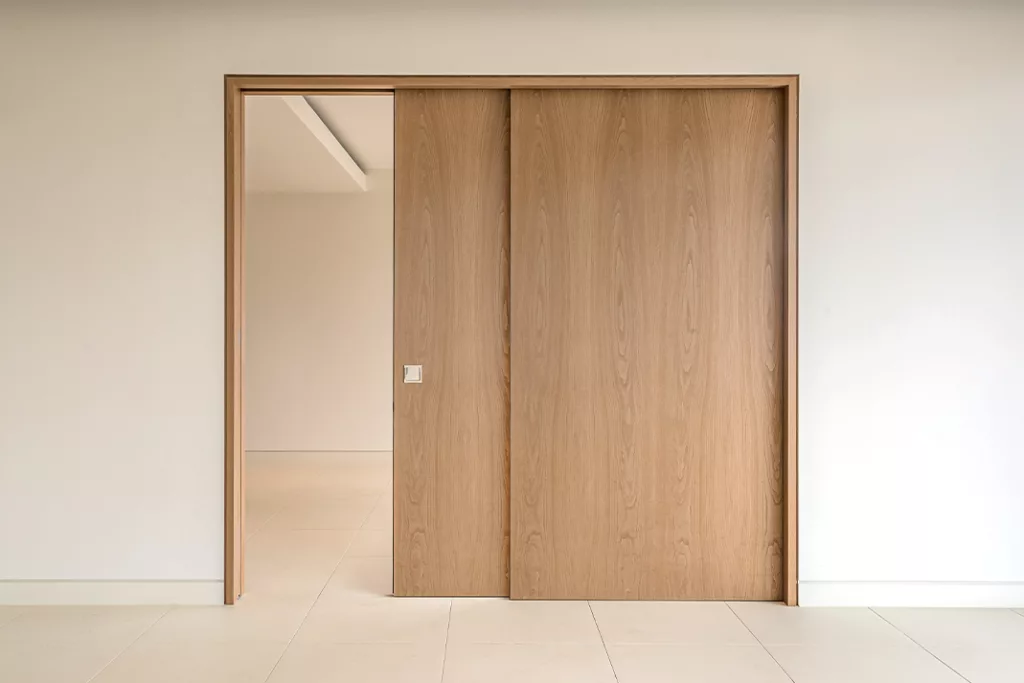
Pocket doors are a fantastic space-saving solution, especially for smaller rooms where every inch counts. These doors slide into the wall, disappearing completely when opened, thus saving valuable floor space. Pocket doors are ideal for tight spaces like bathrooms, closets, or small bedrooms, where traditional swinging doors would take up too much room.
Made of wood, glass, or even metal, pocket doors can be designed to match the rest of your interior decor. They are commonly used where you want to maintain a clean, minimalist look without compromising functionality. Pocket doors also work well for creating open-plan spaces where you might need to separate rooms occasionally but still want to keep the feeling of openness.
Ghost Door

A ghost door is another innovative option for creating a minimalistic, modern home. Similar to invisible doors, ghost doors are designed to blend seamlessly into the surrounding wall, creating a “floating” or “disappearing” effect when closed. However, ghost doors use special finishes, such as frosted or tinted glass or minimal frames, to enhance the illusion of invisibility.
These doors are often used in contemporary homes focusing on high-end design. Ghost doors are great for spaces where you want to maintain the aesthetic flow of a room while still allowing for a private entrance or exit. They are popular in luxury apartments, galleries, and homes with modern or industrial-style interiors.
Arched Door

Arched doors are known for their distinctive, curved tops, adding elegance and classic charm to any room. These doors are often associated with traditional or Mediterranean-style homes but can also be used in contemporary interiors to create a sense of grandeur.
The arched shape of these doors makes them visually striking and can act as a focal point in the room. Arched doors are typically made from wood, but they can also be crafted from materials like glass or steel for a more modern feel. These doors are used for entryways, bathrooms, or even as decorative doors in larger spaces. The soft curve of an arched door adds an inviting and elegant touch to any interior.
Shaker Door

Shaker doors are a timeless and simple option for interiors. Known for their clean, minimalist design, shaker doors feature a flat panel with a framed border. This design is inspired by the Shaker furniture style, which emphasizes practicality, simplicity, and craftsmanship.
Shaker doors are often made from wood and are ideal for traditional and modern homes. They can be stained or painted in various colors, making them highly versatile. Because of their understated design, shaker doors can work in nearly any room—whether you want to add character to a hallway, bedroom, or living room. The simplicity of shaker doors allows them to blend seamlessly with other elements in the room, creating a subtle yet sophisticated look.
Bathroom Door

Bathroom doors are specifically designed to meet the unique needs of bathrooms, where privacy and moisture resistance are essential. These doors are usually made from durable, water-resistant materials like MDF, solid wood, or sometimes even PVC, which can withstand high humidity.
Bathroom doors come in various designs, from traditional panel doors to more modern options like frosted glass doors, allowing light to flow into the space while maintaining privacy. For small bathrooms, pocket or bi-fold doors are often used to save space. Hinged doors are a popular choice in larger bathrooms for their classic appeal. Regardless of the design, a bathroom door is an essential element that provides privacy and moisture protection.
Material Options for Interior Doors
The material of your interior doors plays a significant role in your home’s style and functionality. Each material has unique benefits, and the choice of material depends on factors like aesthetics, durability, cost, and how much natural light you want to let into your space. Let’s explore some popular materials for interior doors and their key features:
Wooden Interior Doors
Wooden interior doors are a classic choice that never goes out of style. Known for their traditional look and long-lasting durability, wooden doors bring warmth and charm to any room. Whether solid or engineered wood, these doors offer a timeless elegance that suits classic and modern home designs.
The durability of wooden doors is one of their standout features. They can withstand the wear and tear of daily use while maintaining their structure and appearance. Over time, wood can even develop a unique patina, adding character and charm to your home. These doors create a cozy, inviting atmosphere in living rooms, bedrooms, and offices.
Wooden doors are also versatile in terms of design. They can be stained, painted, or left in their natural finish to match your decor. For a traditional look, you might choose panel doors with detailed moldings. Simple wood doors can add a minimalist touch for a more modern style. Wooden interior doors offer a wide range of customization, making them an excellent choice for nearly any design style.
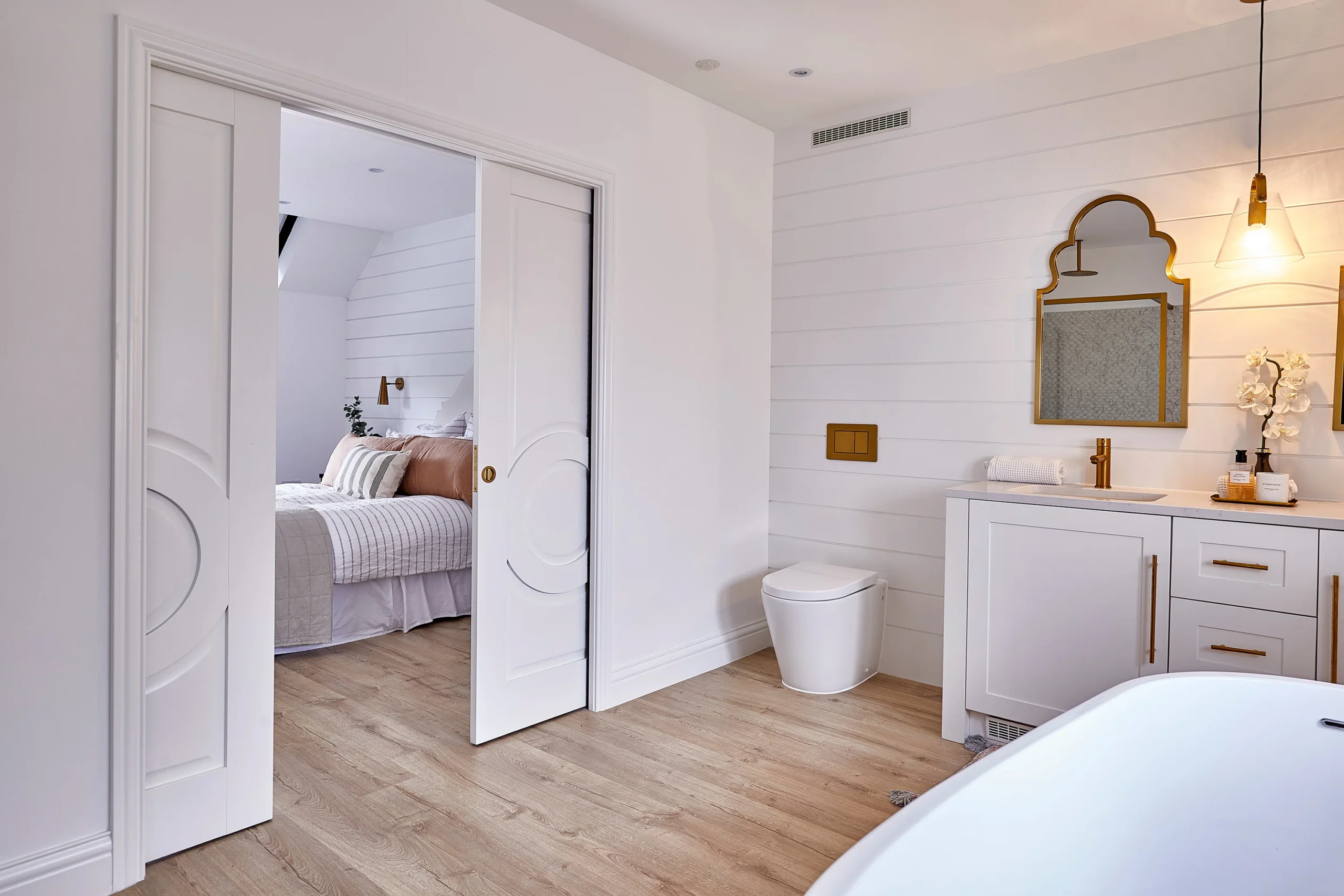
Glass Interior Doors
Glass interior doors are a popular option for those who want to bring more natural light into their home while maintaining separation between rooms. These doors feature transparent or frosted glass panels, which allow light to flow freely through spaces. This is especially beneficial in homes with darker rooms or smaller areas, as it can make a space feel larger and more open.
The clear nature of glass doors creates a sense of openness while providing some privacy. Frosted or etched glass is often used in spaces like bathrooms or home offices, where privacy is essential but natural light is still desired. Glass doors are perfect for connecting rooms like a living room and dining room or leading into a sunroom, where light and openness are key design elements.
In addition to their functional benefits, glass interior doors also contribute to the overall aesthetic of a home. They can be framed with wood, aluminum, or steel to complement your decor, and the glass itself can come in various styles, from clear glass to patterned or frosted finishes. Whether you’re going for a contemporary or industrial look, glass doors can help create a fresh, airy feel in any room.
Composite and MDF Interior Doors
Composite and MDF (Medium Density Fiberboard) doors offer an affordable and durable option for interior doors. These doors are made from a mixture of wood fibers, resins, and other materials, which makes them a strong and reliable choice for those on a budget. MDF doors are particularly known for their smooth surface, which makes them ideal for painting.
One of the major advantages of composite and MDF doors is their cost-effectiveness. These options are generally more affordable and durable than solid wood doors. They resist warping, cracking, and shrinking, which can sometimes happen with traditional wood doors. This makes them great for high-traffic areas like hallways or family rooms.
MDF and composite doors offer a clean, modern look despite being more budget-friendly. They can be finished with various coatings or paint, allowing them to match any interior style. Whether you’re looking for a simple design or something more detailed, these doors can be customized to suit your needs. They also offer good insulation, making them practical for keeping rooms quiet and energy-efficient.
Steel and Aluminum Interior Doors
Steel and aluminum doors are becoming increasingly popular in modern homes due to their strength, durability, and sleek appearance. These doors are commonly used in commercial settings but are also gaining popularity in residential homes, particularly for interior spaces requiring added security or a contemporary aesthetic.
Steel and aluminum doors are highly durable and resistant to wear and tear. They are ideal for areas with a lot of traffic or need extra protection, such as basements, garages, or home offices. These materials are also moisture-resistant, making them a good option for rooms with high humidity, like laundry rooms or bathrooms.
Steel and aluminum doors can be designed with a minimalist look, often featuring smooth, clean lines. These doors’ modern, industrial style works well in contemporary, urban homes. They can also be equipped with various finishes and textures, such as matte or brushed metal, to add visual interest. While steel doors are often heavier than aluminum, both materials offer excellent security and strength.
Choosing the Right Interior Doors for Your Home
Selecting the right interior door can significantly impact your home’s functionality and aesthetic. With so many options available, it’s important to consider various factors such as size, design, budget, and durability. Let’s review the key things to remember when choosing interior doors.
Door Size and Dimensions
One of the first things to consider when choosing an interior door is its size and how it fits within your available space. Doors come in standard sizes, but it’s important to measure your door frame’s width, height, and thickness to ensure a proper fit. A door that is too large or too small for the space can disrupt the room’s flow and require costly adjustments.
In most homes, standard interior doors are 80 inches tall and 30 inches wide, but depending on the style of your home or the specific room, you may need a custom-sized door. You may opt for narrower doors to create more space for smaller rooms, while larger rooms may benefit from wider doors to provide a grander entrance. Don’t forget to consider the door swing (whether it opens inward or outward), as this can affect the room’s layout and flow.
It’s also important to consider the thickness of the door. Standard interior doors are usually around 1 ⅜ inches thick, but thicker doors can provide better soundproofing and insulation. When in doubt, always double-check the dimensions to avoid any fitting issues and ensure that the door enhances the look and functionality of your room.
Door Style and Design Preferences
The design of your interior door plays a major role in defining the overall aesthetic of a room. When choosing an interior door, it’s essential to consider the style and how it fits with the rest of your home’s decor.
For modern homes, sleek flush or glass doors can add a minimalist, contemporary look. If you prefer a more traditional or classic feel, panel doors with intricate moldings can complement your space beautifully. The design of the door should match the interior theme—whether you’re going for a rustic, industrial, or contemporary vibe. For instance, barn doors work well in farmhouses or rustic homes, while French doors are perfect for spaces that need an elegant touch.
Additionally, consider the door’s finish. A wooden door can be stained to enhance its natural grain, while a painted door might offer a brighter, more modern appearance. Glass doors allow natural light to flow between rooms, making them a great choice for living areas or connecting spaces. Whatever your style, the right door design can make your home feel more cohesive and inviting.
Budget Considerations
Your budget is another important factor when choosing interior doors. Depending on the material, size, and design, doors can range significantly in price. While solid wood doors can be expensive, there are many cost-effective options available that still offer good durability and style.
If you’re on a tight budget, consider opting for MDF or composite doors, which offer the look and feel of real wood but at a more affordable price. These doors are still highly durable, easy to maintain, and can be painted to match any decor. On the other hand, if you’re looking for something more luxurious, solid wood, glass, or custom-made doors can provide a more sophisticated look but might come with a higher price tag.
It’s also helpful to factor in the long-term cost. While some materials, like MDF or composite, may cost less upfront, you’ll want to ensure they provide the durability and aesthetic appeal you seek. Sometimes, spending a little more initially on a high-quality door can save you money on repairs or replacements.
Durability and Maintenance
Durability and maintenance are crucial aspects to consider when choosing interior doors. You want doors that will not only look good but also stand the test of time. The material you choose will greatly affect how long your door lasts and how much care it requires.
While beautiful and traditional, wooden doors may require more upkeep to prevent warping, cracking, or fading. Regular sealing and staining can protect the wood and extend its lifespan. On the other hand, MDF and composite doors are more resistant to wear and tear and moisture damage, making them easier to maintain in humid areas like bathrooms or kitchens.
While stylish and allowing natural light to flow, glass doors can be more prone to scratches and smudges. However, frosted or textured glass can help minimize the appearance of fingerprints. Steel and aluminum doors are extremely durable and require minimal maintenance, making them an excellent choice for high-traffic areas.
Regarding maintenance, consider the time and effort you’re willing to invest. Metal or composite doors might be ideal if you prefer a low-maintenance option. However, if you’re drawn to the natural beauty of wood, be prepared for occasional upkeep to keep your doors looking their best.

Benefits of Installing Interior Doors
While installing a pocket door may seem like a manageable DIY project, it’s often best to leave the job to professionals. Professional installation ensures that the pocket door functions properly and lasts for years.
Here are a few reasons why professional installation is highly recommended:
Enhancing Privacy and Noise Control
Interior doors play a vital role in creating private spaces within a home. Whether it’s a bedroom, home office, or nursery, these doors help separate one area from another, keeping noise out and conversations private. For example, a solid-core interior door can significantly reduce sound transfer between rooms. This is especially important in busy households or open-plan layouts where noise can quickly travel. Additionally, having a door you can close allows for better focus during work or study sessions. Choosing the right interior door, such as one with acoustic features, can make a noticeable difference in maintaining peace at home.
Improving Aesthetics
A well-chosen interior door adds more than just functionality—it enhances the overall look of your home. From classic panel designs to sleek, modern styles, interior doors can reflect your taste and tie a room’s design together. For example, shaker-style doors offer a timeless look that complements traditional and contemporary decor. French doors, however, bring elegance and allow natural light to flow between rooms. Even something as simple as updating your door’s hardware or choosing a bold finish can elevate the feel of a space. Remember, your interior doors are not just barriers but part of your home’s personality.
Energy Efficiency
Interior doors contribute to maintaining a comfortable temperature in your home, making them essential for energy efficiency. Closing doors in unused rooms helps contain heat during the winter or keep cool air in during the summer. Additionally, doors with proper insulation, like solid-core or energy-efficient materials, can prevent drafts and reduce the strain on your heating or cooling system. This not only lowers energy bills but also reduces your carbon footprint. Interior doors can help create a cozier and more sustainable living environment when paired with weatherstripping or a proper seal.
You can enjoy privacy, style, and energy savings by thoughtfully selecting and installing interior doors.
Relate FAQ
What are interior doors used for?
Interior doors are used to divide spaces inside a home or building. They provide privacy, reduce noise, enhance aesthetics, and improve energy efficiency by controlling airflow and temperature.
What materials are commonly used for interior doors?
Interior doors are made from various materials, including solid wood, hollow core, MDF (Medium Density Fiberboard), glass, and metal. Each material offers unique benefits in terms of durability, style, and budget.
What is the difference between interior doors and exterior doors?
Interior doors are designed for use inside a home and focus on privacy, noise reduction, and style. They are typically lighter and less durable than exterior doors, built to withstand weather and provide security.
How do I choose the right interior door for my home?
Consider room style, door type (e.g., panel, flush, barn), material, and function. For example, solid wood doors are great for soundproofing, while glass doors add light and openness.
Are sliding doors good for interior use?
Yes, sliding doors, such as barn doors or pocket doors, are excellent for saving space and creating a modern or rustic look. They’re ideal for small spaces or areas without a traditional swing door.
Can interior doors improve energy efficiency?
Yes, interior doors can help control airflow and temperature between rooms, especially when paired with proper weather stripping. Solid wood doors are particularly good at insulating.
How do I maintain my interior doors?
Regular cleaning with a damp cloth and occasional polishing or repainting can keep your doors looking new. Check for loose hinges or hardware and tighten them as needed.
What are the most popular interior door styles?
Popular styles include panel doors, flush doors, French doors, barn doors, pocket doors, and Shaker doors. Each offers a unique look to match different interior designs.
Can I replace my interior doors without changing the frame?
Yes, replacing just the door slab is possible if the existing frame is in good condition. This is a cost-effective way to update the look of your home.
Are custom interior doors worth the investment?
Custom interior doors are worth it if you want a unique style, specific dimensions, or premium materials. They add a personal touch and can significantly enhance your home’s value.
Share This Story, Choose Your Platform!
Send Us A Message
*100% Privacy Guaranteed

